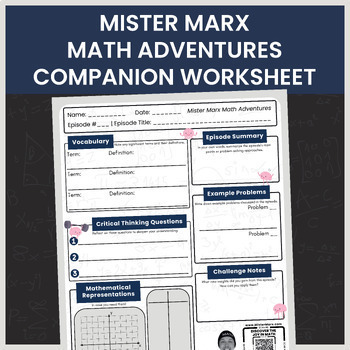Mister Marx Math Adventures Companion Worksheet | @MisterMarx on YouTube
- PDF
- Easel Activity
Description
MISTER MARX MATH ADVENTURES COMPANION WORKSHEET | @MisterMarx on YouTube
OVERVIEW: Mister Marx Math Adventures on YouTube is an innovative and captivating educational series designed to empower learners of all ages to ‘Discover the Joy in Math.’ With a dynamic teaching style that makes complex concepts accessible, Mister Marx transforms traditional math learning into an exciting journey, brimming with discovery and intellectual challenge. The Companion Worksheet activity complements each episode by providing a structured framework for students to engage with the content actively. It encourages critical thinking, reinforces key concepts, and enables learners to document their insights, fostering a deeper connection with the material. This comprehensive approach embodies Mister Marx's philosophy of learning through exploration, ensuring that every mathematical adventure is not just educational but also enjoyable and memorable.
To fully benefit from this resource, students will need access to the internet to watch the corresponding episodes on YouTube via computer or laptop.
This versatile product can be printed multiple times and used repeatedly for your convenience.
LEARNING TARGETS:
- Students will identify and articulate key mathematical concepts presented in the episode.
- Students will apply critical thinking skills to solve example problems and challenges.
- Students will demonstrate the ability to summarize mathematical ideas in their own words.
- Students will enhance their mathematical vocabulary by defining terms & notations used.
- Students will develop a growth mindset by learning from mistakes & persisting through difficult problems.
- Students will illustrate mathematical concepts using visual representations when applicable.
- Students will challenge themselves to think beyond the answer to understand the math behind the solution.
Links:




